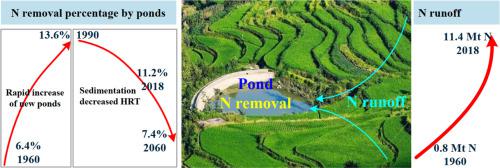当前位置:
X-MOL 学术
›
Water Res.
›
论文详情
Our official English website, www.x-mol.net, welcomes your feedback! (Note: you will need to create a separate account there.)
Diminished storage capacity of ponds caused by sedimentation weakens their nitrogen removal efficiency
Water Research ( IF 11.4 ) Pub Date : 2024-06-21 , DOI: 10.1016/j.watres.2024.121987 Mingquan Lv 1 , Jilong Chen 1 , Maohua Ma 1 , Ping Huang 1 , Shengjun Wu 1
Water Research ( IF 11.4 ) Pub Date : 2024-06-21 , DOI: 10.1016/j.watres.2024.121987 Mingquan Lv 1 , Jilong Chen 1 , Maohua Ma 1 , Ping Huang 1 , Shengjun Wu 1
Affiliation

|
Though their small size, ponds play a disproportionately crucial role in eliminating nitrogen (N) transporting to downstream freshwaters. As significant water infrastructures, ponds are non-sustainable due to loss of storage capacity resulting from sedimentation. However, the effects of pond sedimentation on N removal is widely neglected in landscape N processing. The NUFER (Nutrient flows in Food chains, Environment and Resources use) model was employed to estimate N runoff from 1960 to 2018. We reconstructed the dynamic of number and storing capacity of about 14 million ponds due to construction and sedimentation from 1960 to 2018, projecting these trends into the year 2060. Our approach incorporated first-order kinetic reactions, including water residence time (HRT), to estimate N removal of ponds, utilizing data 6 monitoring ponds and 81 ponds from literature studies. Our analysis reveals a fourteen-fold increase in N runoff over the past six decades, rising from 0.8 Mt N in 1960 to 11.4 Mt N in 2018. Due to the initial rapid expansion of ponds, N removal by ponds increased from 6.4 % in 1960 to 13.6 % in 1990. Sedimentation is prevalent in ponds, particularly in small ponds with a sedimentation accumulation rate of 2.96 cm yr. Pond sedimentation, which reduces HRT, resulted in a decrease in pond N removal percentage to 11.2 % in 2018 and a projected 7.4 % by the year 2060, assuming similar sediment accumulation rates persist in the future. Overall, our findings underscore the non-negligible role of ponds as landscape nodes in N cycling. Urgent mitigation measures are needed to extend the lifetime of existing ponds and sustain their critical role in water quality management.
中文翻译:

沉积造成池塘蓄水能力下降,脱氮效率下降
尽管池塘面积很小,但在消除氮 (N) 向下游淡水输送方面发挥着极其重要的作用。作为重要的水利基础设施,池塘由于沉积导致存储能力丧失,因此不可持续。然而,在景观氮处理中,池塘沉积对氮去除的影响被广泛忽视。采用NUFER(食物链、环境和资源利用中的营养流)模型来估算1960年至2018年的氮径流。我们重建了1960年至2018年由于建设和沉积而导致的约1400万个池塘的数量和存储能力的动态,将这些趋势预测到 2060 年。我们的方法结合了一级动力学反应,包括水停留时间 (HRT),利用文献研究中的 6 个监测池塘和 81 个池塘的数据来估计池塘的氮去除量。我们的分析显示,过去 60 年,氮径流增加了 14 倍,从 1960 年的 0.8 吨氮增加到 2018 年的 11.4 吨氮。由于池塘最初的快速扩张,池塘的氮去除量从 1960 年的 6.4% 增加1990 年达到 13.6%。池塘中普遍存在沉积现象,尤其是小池塘,沉积累积率为 2.96 厘米/年。池塘沉积会降低水力停留时间,导致池塘氮去除率在 2018 年下降至 11.2%,预计到 2060 年将下降 7.4%(假设未来仍保持类似的沉积物积累率)。总体而言,我们的研究结果强调了池塘作为氮循环景观节点的不可忽视的作用。需要采取紧急缓解措施来延长现有池塘的使用寿命并维持其在水质管理中的关键作用。
更新日期:2024-06-21
中文翻译:

沉积造成池塘蓄水能力下降,脱氮效率下降
尽管池塘面积很小,但在消除氮 (N) 向下游淡水输送方面发挥着极其重要的作用。作为重要的水利基础设施,池塘由于沉积导致存储能力丧失,因此不可持续。然而,在景观氮处理中,池塘沉积对氮去除的影响被广泛忽视。采用NUFER(食物链、环境和资源利用中的营养流)模型来估算1960年至2018年的氮径流。我们重建了1960年至2018年由于建设和沉积而导致的约1400万个池塘的数量和存储能力的动态,将这些趋势预测到 2060 年。我们的方法结合了一级动力学反应,包括水停留时间 (HRT),利用文献研究中的 6 个监测池塘和 81 个池塘的数据来估计池塘的氮去除量。我们的分析显示,过去 60 年,氮径流增加了 14 倍,从 1960 年的 0.8 吨氮增加到 2018 年的 11.4 吨氮。由于池塘最初的快速扩张,池塘的氮去除量从 1960 年的 6.4% 增加1990 年达到 13.6%。池塘中普遍存在沉积现象,尤其是小池塘,沉积累积率为 2.96 厘米/年。池塘沉积会降低水力停留时间,导致池塘氮去除率在 2018 年下降至 11.2%,预计到 2060 年将下降 7.4%(假设未来仍保持类似的沉积物积累率)。总体而言,我们的研究结果强调了池塘作为氮循环景观节点的不可忽视的作用。需要采取紧急缓解措施来延长现有池塘的使用寿命并维持其在水质管理中的关键作用。
















































 京公网安备 11010802027423号
京公网安备 11010802027423号